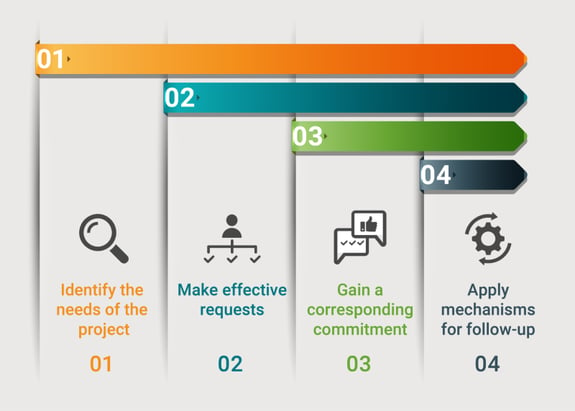"How do I hold my people accountable?" Every manager has asked this question at least once, if not once a week. But here’s the thing: the question itself is a trap. You shouldn’t have to “hold” people accountable.
Holding people accountable is not a manager's responsibility

It's not your job to make sure other people do what they said they would do; it’s the responsibility of your reports to be accountable to their commitments. Instead, as the manager, it’s your job to lead a productive process that ensures accountability.
It’s about taking the complicated, messy, shifting work your team does, and boiling it down to firm commitments that make it clear who’s accountable for what.
These might seem like simple concepts, but the moving parts in a given project make them complex. Add in humans, miscommunication, and competing priorities, and the end result can feel darn near impossible. Which is why you need an accountability process!
An accountability process helps you think through all the moving parts of your project so you can identify pitfalls and problems as they happen (sometimes even before).
1. Identify the needs of the project
As a manager, it’s your job to take all the moving parts of a project, translate them to your team and get them (and the work) to a deadline. The first part of the process starts with you.
The 4 steps to identifying project needs

2. Make an effective request
The next step is to take the project to your team with an effective request. Your ability to get your requests right will put you on the path to making sure work is happening how and when you need it.
Seems like it should be simple, right? And sometimes it is… especially if the ‘ask’ is straightforward. But, it can get a whole lot harder to make an effective request when the work is complex.
WHO
Clarifying roles is critical to get work underway quickly and shift the work from your to-do list to that of your team.
WHAT
Being specific about what you want the person(s) to do, the acceptance criteria (or definition of “done”), allows them to spring into action and creates an opportunity for further alignment.
HOW
Provide details about how you envision the work getting done, or how much flexibility and choice you want the person to have.
WHEN
Establishing a clear deadline creates the right level of urgency and clarifies the priority relative to other tasks, allowing you to move on to other things until that deadline nears.
WHY
Understanding the ‘why behind the what’ is important to human beings. We all like to understand why we are putting our time and energy into something and how our part fits into the larger picture.
3. Corresponding commitment
Once you’ve asked a team member to shoulder the load, you have to make sure they are really accepting your request. Team members could respond in multiple ways: Have you ever found yourself wondering, “Whatever happened to that report I asked my team to create?” or “Hmm, did that meeting we discussed in our status call ever get set up?” If so, you may need your team to give firmer commitments to executing your requests.
Once you’ve asked a team member to shoulder the load, you have to make sure they are really accepting your request. Team members could respond in multiple ways:
ACCEPT |
"Got it! I'm on it. I"ll let you know when I start and ask you if I have any questions." |
COUNTER |
“I can do that, but I don’t know how to do part of it. I’ll ask Lila to help with that part. I’ll let you know if Lila can’t help.” |
DELAY |
“I’ve got to move some things around to make sure I can do that. I’ll let you know by noon." |
DECLINE |
“I’m really too busy to take that on.” |
NON-ACCEPT, ACCEPTANCE |
“Got it! I’ll see what I can do.” |
Obviously, the ideal is that your team member flat-out accepts and the project gets started. The counter-offer works, too, as your team member is clearly taking on the request and has solved a problem from the original request. This is great because he’s not putting the work back on you -- thank you very much!
The delay, while not ideal, is a commitment because he is taking action and has communicated his plan. Now, you might not like his plan and choose to pivot, but his intentions are clear. Same story with the choice to decline.
The non-accept, acceptance is problematic. It creates tension for you because you don’t know for sure if he’s going to do the project and it leaves a lot of room for the possibility that you won’t get what you need.
As managers, we have to be on the lookout for delays, non-accept, acceptances, and non-responses. In all three of the situations, the load is still sitting on your shoulders. Make sure you have commitment before moving to the next step.
* If you are having trouble getting commitment, other challenges may exist. It may come down to their skill, will or hill.
Finally, if you give someone a project, you’ll likely want to have periodic check-ins to make sure the project is on track.
4. Mechanisms for follow up
This is where it really pays off to have an accountability process. Depending on how complicated the project is, you might be checking in with them along the way, or simply waiting for them at the end to see how they did. But, no matter what, you are checking in.
If done thoughtlessly, the act of following up can feel a bit like babysitting. But with the right mechanisms in place, it shouldn’t. While the mechanisms for follow-up will vary, all successful mechanisms share four traits:
| EXPECTED | Everyone knows the mechanism exists |
| EXPLICIT | Everyone understands its purpose |
| AGREED-UPON | Everyone agrees to, and participates in, the mechanism |
| HONORED | Everyone engages until the group agrees to a different mechanism |
Your mechanisms will be determined by the project, your team, and their abilities, so they may shift. But ultimately, your team, whether they know it or not, is looking for these mechanisms to help them stay accountable to their commitments.
Mechanisms many effective managers use
|
DAILY STAND-UPS |
|
| PROJECT TRACKERS Create a place where you and the team can see “the work”, ask questions, and seek updates in real time. When you first start a process like this it can feel burdensome for some items, but if made a part of a team’s routine can help save time, avoid miscommunication, and stop project delays before they happen. Plus, you probably already have access to software that allows this level of team integration. And it doesn’t have to be complex. For instance, Google Docs has the ability to tag and message people built into its functionality. |
|
| SCHEDULED CHECK-INS These will vary depending on the project and the work. But taking the time to calendar a check-in on your and your team’s calendars means you all have a real-time reminder the work is ongoing, due, or scheduled. Take 5–10 minutes to schedule repeating meetings at a time that works for all involved so that the project doesn’t get lost in the shuffle. |
Teams operating without an accountability process tend to waste valuable mental and emotional energy (not to mention time and morale) to deal with unnecessary tension, confusion, and all the ripple effects that come with such misalignment. So save everyone the stress and instead, empower everyone on your team with the confidence of knowing what they're responsible for delivering, to whom, and when. Taking the time to create and adhere to an accountability process—a usable method for ensuring accountability across your team—is one of the very best things you can do for your team and for yourself as a manager.
Download a PDF version of this blog post here.
We'd love to hear from you!


